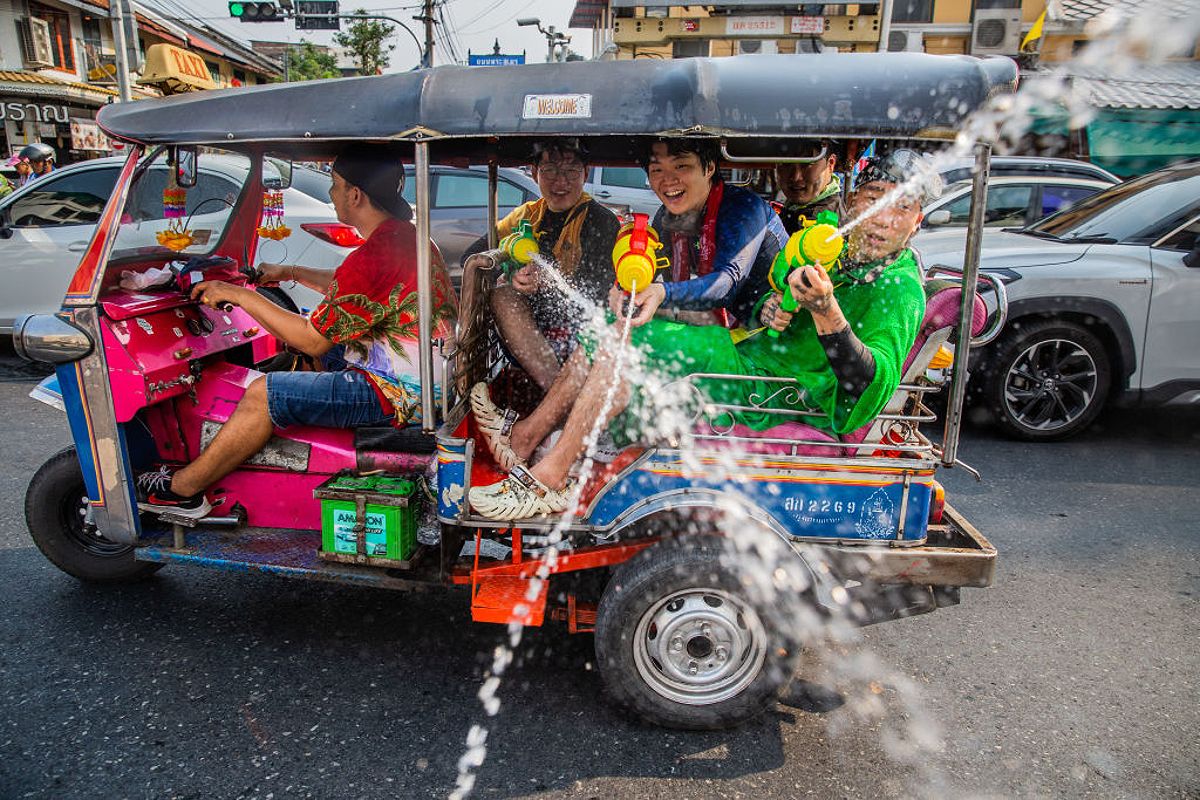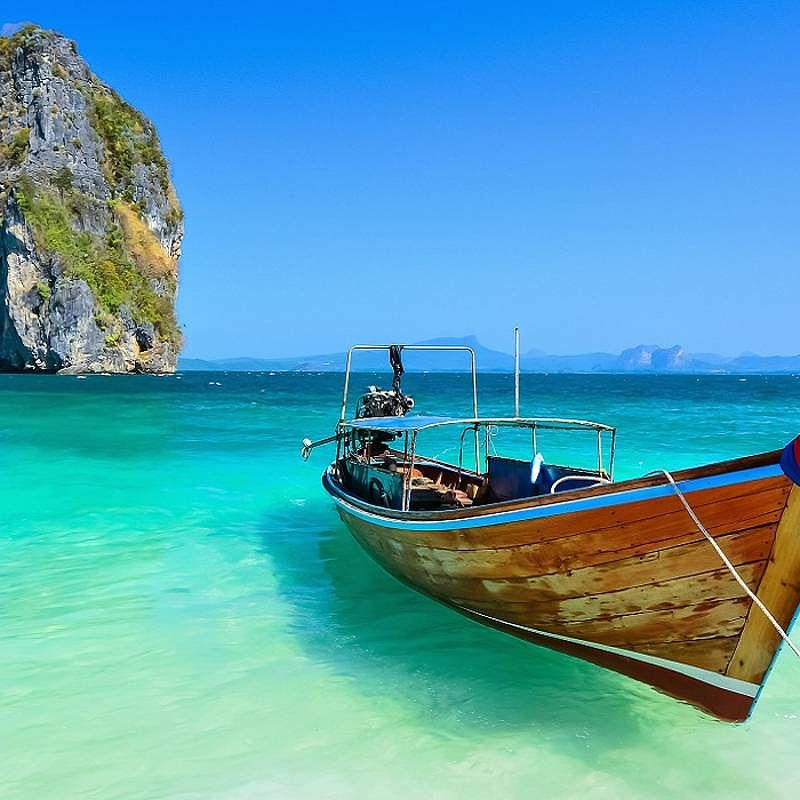Thailand experiences three distinct seasons, each offering its own unique allure. Understanding the pros and cons of each can help you determine the best time to travel to Thailand, aligning your trip with your priorities and ensuring a truly remarkable journey.
Understanding Thailands Seasonal Charms
The Dry Season (November – April): The Peak of Beach Bliss
The dry season is often considered the best time to travel to Thailand, particularly for beach lovers. During these months, the weather is consistently pleasant, with sunny skies, low humidity, and minimal rainfall. This makes it the perfect time to explore the country’s renowned coastal destinations, such as Phuket, Krabi, and Koh Samui. However, this popularity also means that the dry season is the busiest and most expensive time to travel, as hordes of tourists flock to Thailand’s picturesque shores.
In December, the festive spirit is palpable, especially around Christmas and New Year. Many travelers are drawn to Thailand during this time to escape the winter chill of their home countries. Expect vibrant nightlife, bustling markets, and lively street parties. It’s also the ideal time for outdoor activities, such as snorkeling, diving, and island-hopping, as the sea conditions are generally calm.
| Season | Months | Weather | Activities | Pros | Cons |
|---|---|---|---|---|---|
| Dry Season | November – April | Sunny, low humidity, minimal rainfall | Beach activities, snorkeling, diving, exploring temples, festivals | Pleasant weather, ideal for beach activities, vibrant festivals | Crowds, higher prices |

The Hot Season (March – May): Vibrant Festivals and Cultural Immersion
The hot season in Thailand is known for its, well, heat. Temperatures can soar, with midday highs often reaching into the 90s Fahrenheit (around 35°C). While this may seem less than ideal for some, the hot season offers its own unique charms. It’s a time of vibrant festivals, such as the renowned Songkran (Thai New Year) celebrations in mid-April, where the entire country comes alive with joyous water fights and cultural traditions.
During this period, you can experience Thailand’s rich culture firsthand. Many locals celebrate Songkran by visiting temples, engaging in family gatherings, and performing rituals to cleanse themselves for the new year. Although the heat can be intense, mornings and evenings provide a pleasant respite, making it an excellent time to explore cities like Bangkok and Chiang Mai, where the nightlife is equally vibrant.
| Season | Months | Weather | Activities | Pros | Cons |
|---|---|---|---|---|---|
| Hot Season | March – May | Hot and humid, occasional showers | Festivals, cultural immersion, exploring cities | Vibrant festivals, cultural experiences, lower prices | Intense heat, humidity |

The Wet Season (June – October): A Lush, Budget-Friendly Alternative
The wet season in Thailand is often overlooked, but it can be an equally rewarding time to visit. While the country does experience more frequent and intense rainfall during these months, the lush landscapes, lower prices, and fewer tourists can make it an excellent choice for savvy travelers. The Gulf of Thailand islands, such as Koh Samui and Koh Phangan, tend to experience less rain than the Andaman Coast, making them a popular wet season destination.
In addition to lower accommodation rates, visiting during the wet season offers a unique perspective on Thailand’s natural beauty. The countryside flourishes with greenery, and waterfalls are at their most spectacular. While you may encounter some rain, it usually comes in short, heavy bursts, leaving plenty of time for sunbathing or exploring local attractions.
| Season | Months | Weather | Activities | Pros | Cons |
|---|---|---|---|---|---|
| Wet Season | June – October | Frequent rainfall, lush landscapes | Waterfalls, trekking, exploring islands | Lush landscapes, fewer crowds, lower prices | Rainfall, potential for disruptions |
Discovering the Best Time to Travel to Thailands Beaches
Thailand’s diverse geography means that different regions experience the seasons in unique ways, offering a range of optimal beach-going experiences throughout the year.
The Andaman Coast (Phuket, Krabi, Phi Phi Islands): Dry Season Bliss
The Andaman Coast, home to iconic destinations like Phuket, Krabi, and the Phi Phi Islands, is best visited during the dry season (November – April). This is when the weather is at its most stable, with plenty of sunshine and calm seas, making it ideal for water activities like snorkeling and diving. The dry season also coincides with the peak tourist influx, which means popular beaches can be crowded.
If you prefer a quieter experience, consider visiting in late April or early May, just before the wet season begins. The weather remains warm, and you can enjoy a more serene atmosphere while still benefiting from good beach conditions. As the wet season approaches, some businesses may begin to offer discounts, making it a budget-friendly option.
Dry Season:
- Phuket: Patong Beach, Kata Beach, Karon Beach
- Krabi: Railay Beach, Ao Nang Beach, Phra Nang Beach
- Phi Phi Islands: Maya Bay, Tonsai Bay, Loh Dalum Bay
Wet Season:
- Phuket: Kamala Beach, Nai Harn Beach, Surin Beach
- Krabi: Ao Phra Nang Beach, Tubkaak Beach, Ao Lanta Yai
- Phi Phi Islands: Loh Samah Bay, Long Beach, Phi Phi Leh

The Gulf of Thailand (Koh Samui, Koh Phangan, Koh Tao): Year-Round Beach Heaven
The Gulf of Thailand, with its stunning islands like Koh Samui, Koh Phangan, and Koh Tao, experiences a slightly different seasonal pattern. The dry season in this region runs from December to August, while the wet season spans from September to November. The Gulf of Thailand islands generally see less impact from the monsoon rains, making them a viable option for beach-goers even during the wetter months.
Koh Samui is particularly famous for its beautiful beaches and vibrant nightlife. If you’re looking to enjoy the island’s famous Full Moon Party, plan your trip around the lunar calendar. The festive atmosphere combined with lively beach parties makes for an unforgettable experience. However, if you prefer a more tranquil environment, visiting during the shoulder months of December or early May can provide a balance of good weather and fewer crowds.
Dry Season:
- Koh Samui: Chaweng Beach, Lamai Beach, Lipa Noi Beach
- Koh Phangan: Haad Rin Beach, Haad Yao Beach, Thong Sala Beach
- Koh Tao: Sairee Beach, Chalok Baan Kao Bay, Mae Haad Bay
Wet Season:
- Koh Samui: Bang Po Beach, Choeng Mon Beach, Mae Nam Beach
- Koh Phangan: Haad Salad Beach, Haad Thian Beach, Haad Khom Beach
- Koh Tao: Tanote Bay, Mango Bay, Shark Bay
The Southern Islands (Koh Lanta, Koh Lipe, Koh Kood): Secluded Serenity
The southern islands of Thailand, such as Koh Lanta, Koh Lipe, and Koh Kood, offer a more secluded and tranquil beach experience. The best time to visit these destinations is during the dry season (November – April), when the weather is consistently pleasant and the seas are calm. These islands are less commercialized than some of the more popular destinations, allowing for a more authentic experience.
During the wet season, while some facilities may close temporarily, the natural beauty of these islands is at its peak. The lush greenery and vibrant marine life create a picturesque backdrop for those willing to embrace the occasional rain shower. This is an excellent time for eco-tourists and nature lovers to explore the unique flora and fauna of these islands.
Dry Season:
- Koh Lanta: Klong Dao Beach, Long Beach, Klong Nin Beach
- Koh Lipe: Pattaya Beach, Sunrise Beach, Sunset Beach
- Koh Kood: Klong Chao Beach, Ao Tapao Beach, Ao Yai Beach
Wet Season:
- Koh Lanta: Lanta Old Town, Mu Ko Lanta National Park, Lanta Animal Welfare
- Koh Lipe: Walking Street, Koh Lipe Marine National Park, snorkeling and diving excursions
- Koh Kood: Klong Chao Beach, Ao Tapao Beach, Ao Yai Beach
Making the Most of Your Thai Beach Vacation
To ensure your beach getaway in Thailand is truly unforgettable, consider these tips to make the most of your experience.
Embrace the Rain
While the wet season may bring more frequent showers, don’t let that deter you. Thailand’s rain showers are often short-lived and intense, leaving you with ample time to enjoy the sunshine and explore the stunning beaches. Pack a lightweight raincoat or umbrella and embrace the refreshing break from the heat. Additionally, the rain can lead to some of the most spectacular sunsets, as storm clouds clear to reveal vibrant colors painting the sky. This is a perfect opportunity for photography enthusiasts to capture stunning views that are less common during the dry season.
Explore Beyond the Beaches
Thailand offers much more than just its breathtaking beaches. Venture beyond the sand and surf to discover the country’s vibrant markets, ancient temples, and lush tropical landscapes. Immerse yourself in the local culture and engage with the friendly Thai people for a truly enriching experience. Consider taking a cooking class to learn how to prepare authentic Thai dishes or join a guided tour to explore historical sites like Ayutthaya or Sukhothai. These experiences not only provide a break from the beach but also allow you to appreciate the rich history and culture of Thailand.
Dive into Local Cuisine
No trip to Thailand would be complete without indulging in the country’s renowned culinary delights. From fresh seafood to spicy curries and flavorful street food, Thailand’s cuisine is a true treat for the senses. Embrace the opportunity to sample local specialties and immerse yourself in the flavors that make this destination so unique. Don’t miss out on trying dishes like Pad Thai, Tom Yum Soup, and Green Curry. Street food markets, especially in cities like Bangkok and Chiang Mai, offer a wide variety of options at affordable prices. Exploring these markets can be a culinary adventure in itself, as you discover new flavors and ingredients.
FAQ
Q: Is it possible to swim in the ocean during the wet season in Thailand?
A: Yes, but be cautious. Strong currents and rough waves are more common during the wet season. Check local weather forecasts and follow safety guidelines before entering the water.
Q: What are the best beaches in Thailand for snorkeling and diving?
A: The Andaman Coast is renowned for its exceptional snorkeling and diving sites. The Phi Phi Islands, Similan Islands, and Surin Islands are particularly popular destinations.
Q: What are the best beaches in Thailand for families with young children?
A: Beaches with calm, shallow waters are ideal for families with young children. Some excellent options include Karon Beach in Phuket, Kata Beach in Phuket, and Lamai Beach in Koh Samui.
Conclusion
Thailand’s diverse range of beach experiences, coupled with its varied seasonal offerings, make it a true paradise for travelers seeking sun, sand, and serenity. By understanding the nuances of the country’s weather patterns and the best times to visit specific regions, you can plan the ultimate beach getaway that aligns perfectly with your preferences and priorities. Whether you’re drawn to the dry season’s ideal conditions or the wet season’s lower prices and fewer crowds, Thailand’s beaches are sure to captivate and delight you throughout the year. Plan your Thai beach vacation today and discover the perfect time to visit this captivating destination.
